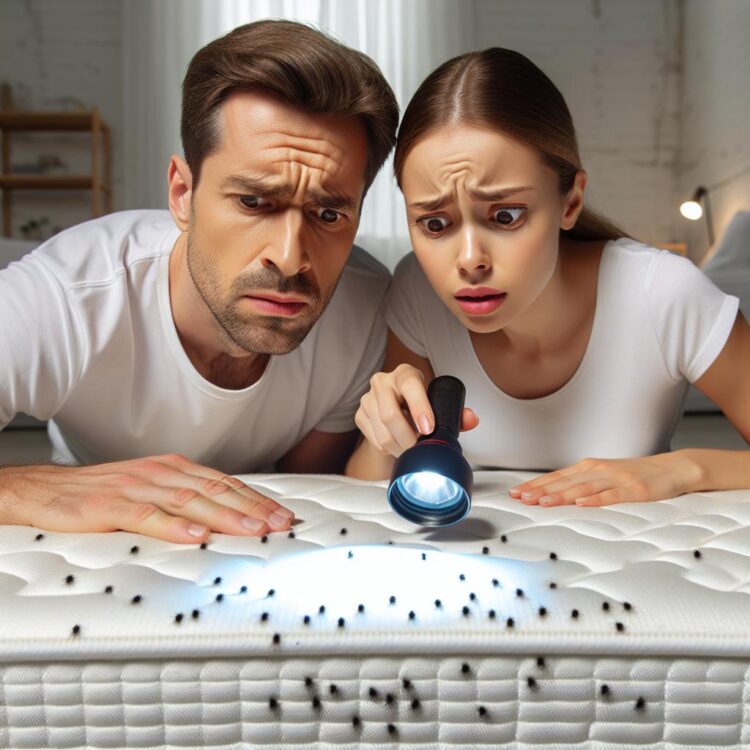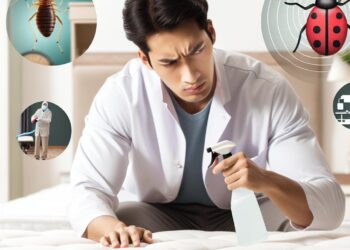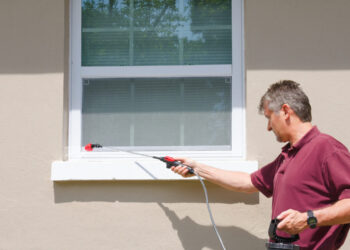Waking up with itchy bites and mysterious red marks on your skin? Or maybe you’re noticing tiny blood stains on your sheets? These can be unsettling signs of a bed bug infestation, a problem that can turn charming homes and thriving businesses into nightmares. Bed bugs aren’t just a household hassle; they can significantly impact your health and mental well-being. Infestations may lead to allergic reactions and increased anxiety. That’s why controlling these sneaky pests is crucial. In this blog, we’ll tackle common bed bug problems head-on, offering practical solutions to help you reclaim your comfortable living and working spaces. Whether you’re a homebody or a business owner, rest assured, we’ve got you covered.
Recognizing Bed Bug Infestation: Key Signs and Characteristics
Bed bugs are those tiny, sneaky creatures that no one wants to encounter. They’re little insects, reddish-brown in color, and they love to hide out during the day. Bed bugs prefer to stick around mattresses, bed frames, and headboards—anywhere they can stay out of sight and close to their next meal: you! They come out at night looking to feed on human blood, leaving us with itchy bites. Now, let’s talk infestation signs. First, you might notice red, itchy welts on your skin, often in a straight line or clustered in groups. Second, keep an eye out for small, rust-colored stains on your sheets or mattress. These are often bed bug droppings or blood spots. Lastly, there’s the peculiar, musty odor that an infestation emits—a smell many describe as overripe raspberries. Recognizing these tell-tale signs early can save you a lot of trouble in the long run.How to Spot and Tackle the Most Common Bed Bug Problems
So, you suspect you might have a bed bug infestation? Don’t worry; identifying the signs early can save you a heap of trouble. Let me walk you through common problems this little nightmare can cause by pinpointing three tell-tale signs. Understanding these issues can help you tackle the problem more effectively.- Tiny Blood Stains on Bedding: While you’re catching some Z’s, bed bugs might be busy feasting, leaving those small, rusty spots on your sheets. It’s not just about keeping your bed clean – persistent stains make your bedding less appealing and might lead to frequent replacements, ultimately increasing your household expenses. Additionally, these blood stains can harbour diseases, posing a health risk to you and your family.
- Unwelcome Musty Odour: Ever noticed a strange, musty smell in your room? Bed bugs release pheromones, which lead to an uninviting scent. This odour can seep into your clothes, upholstery, and other fabrics, leading to continuous contamination. Eventually, if friends and potential buyers notice it, this could devalue your property.
- Itchy Red Bites: This means bed bugs have targeted you as their midnight snack! Besides being downright annoying, these bites can cause itchiness and lead to secondary skin infections if scratched, adversely affecting your health. Furthermore, if you’ve got pets, they’re not safe either. Bed bug bites can torment your furry friends, causing them discomfort and potential skin problems.
Effortless Home Remedies for Identifying Bed Bug Infestations
Encountering bed bugs at home? What a nightmare! But, don’t worry. There are plenty of natural ways to tackle these little pests without using harsh chemicals. Let’s dive into some eco-friendly and non-toxic DIY remedies to help you get rid of bed bugs safely and effectively.- Essential Oils: Oils like tea tree, lavender, and peppermint can be powerful against bed bugs. To use them, mix 20 drops of your chosen essential oil with water in a spray bottle. Spray this mixture on affected areas like mattresses and crevices. The strong scent and natural insecticidal properties of these oils repel bed bugs, disrupting their ability to reproduce.
- White Vinegar: Vinegar’s high acidity serves as a bug deterrent. Simply fill a spray bottle with white vinegar and spray it along cracks, crevices, and entry points. Vinegar is effective at killing bed bugs on contact, but remember, it won’t eliminate eggs.
- Diatomaceous Earth: This is a fine powder made from fossilized aquatic organisms and acts as a natural desiccant. Sprinkle it lightly on carpets, in cracks, and around bed frames. It works by dehydrating bed bugs and is safe for humans and pets when used correctly.
- Baking Soda: Known for drying out moisture, baking soda can dehydrate bed bugs. Sprinkle it in thin layers in affected areas, leave it on for a week, then vacuum it up. Repeat as needed. Although its effectiveness is debated, it can provide a temporary solution.
- Herbal Sprays: Certain herbs such as mint, thyme, or rosemary can fend off these pests. Brew a strong tea with one of these herbs, let it cool, and use it to spray pest hotspots. Their scent and natural properties act as a deterrent.
- Traps: Sticky traps can physically capture bugs. Place these around bed legs or wherever you suspect bed bug activity. While these won’t solve the infestation, they can help monitor the severity and reduce numbers.
- Natural Predators: Bugs like spider beetles or centipedes can naturally keep bed bugs at bay. While it’s not realistic to keep these around long-term indoors, encouraging a balanced garden habitat outside can help prevent pests.
Use chemicals to eliminate bed bugs efficiently and effectively.
Do you think you’ve got a bed bug problem? Don’t worry; many folks have been in your shoes. When it comes to identifying these pesky critters, there are some tell-tale signs you might notice. Tiny rust-coloured spots on your sheets or mattress could be their droppings, and an odd musty smell might linger in the room. And those red, itchy welts on your skin? They could be the result of an unwelcome midnight snack. Spotting these signs? It’s time to act fast.So, you’ve confirmed a bed bug invasion—what next? Many people turn to chemical treatments to tackle these unwanted guests. Here are some chemical options you could consider:
- Permethrin: This chemical disrupts the nervous system of bed bugs. Spray it directly on infested areas but avoid skin contact, as it can be irritating.
- Deltamethrin: Effective for contact and residual treatment. Use it for cracks and crevices where bed bugs love to hide.
- Neonicotinoids: They attack the nervous systems of insects. Apply with care on fabrics and upholstery, following the instructions closely.
- Pyrethrins: These chemicals are biodegradable. Use them for a quick knockdown by applying directly to bugs on sight.
Effective Prevention Tips to Keep Bed Bugs Out of Your Home
It’s important to stay on top of potential pest problems before they become absolute nightmares. An effective way to ensure your home stays pest-free is by adopting prevention strategies. Here’s a structured list to guide you through:- Proper Waste Disposal and Cleanliness: Keep your home tidy and dispose of rubbish regularly. Pests like rodents and cockroaches are attracted to leftover food and rubbish bins.
- Sealing Entry Points and Cracks: Regularly inspect your home for cracks and holes that might serve as entry points for pests. Use caulk or other appropriate materials to seal them.
- Using Pest Deterrents: Install screens on windows and doors to prevent pests from entering. Consider using natural deterrents like essential oils or herbs, which can be effective and non-toxic.
- Regular Inspections and Maintenance: Schedule regular inspections for signs of pests. Look for droppings, nest materials, or unusual smells. If needed, consult professional pest control services for a thorough check.
- Garden Maintenance: Keep your garden neat and remove any debris, as these can attract pests. Trim trees and bushes to keep them from touching your house, preventing easy access to pests.
- Proper Food Storage: Store food items in airtight containers to keep them safe from pests. Ensure your pantry is clean and free of crumbs.
- Check for Leaks: Fix any leaks promptly, as moisture can attract pests like termites and mould-producing insects.
- Pet Care: If you have pets, make sure their bowls are clean and food is not left out for too long, as this can attract pests like ants or flies.
Dispelling Myths: Understanding Bed Bug Infestation Signs Clearly
| Myth | Fact |
|---|---|
| Bed bugs only infest dirty homes. | Bed bugs can thrive in any environment, clean or dirty, as long as they have access to a food source, namely human blood. |
| You can feel bed bug bites immediately. | Most people do not feel bed bug bites until hours or even days later, as they inject an anesthetic before feeding. |
| Bed bugs transmit diseases like other pests. | Unlike mosquitoes or ticks, bed bugs are not known to spread diseases, though they can cause itching and allergic reactions. |
| If you can’t spot them, you don’t have bed bugs. | Bed bugs are experts at hiding in cracks and crevices, making them difficult to detect without searching for specific signs. |
| DIY solutions will always eliminate bed bugs. | Though some treatments might reduce numbers, professional extermination is often necessary for complete removal. |















